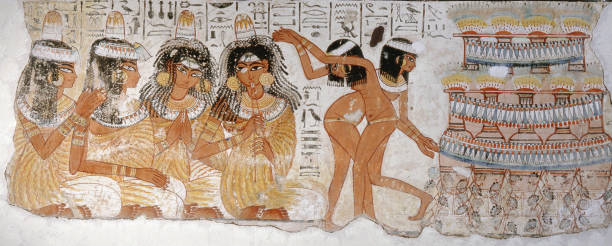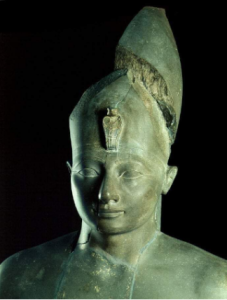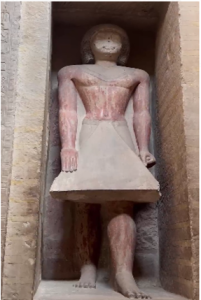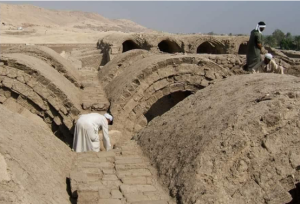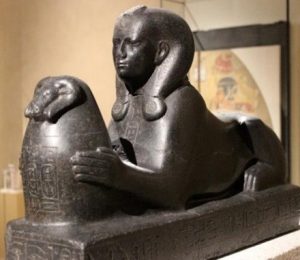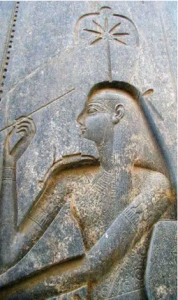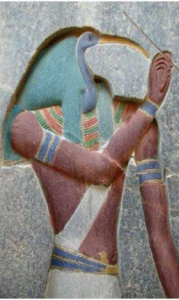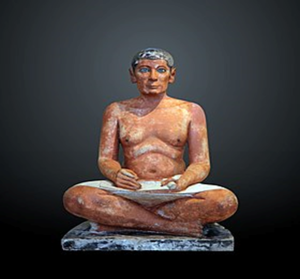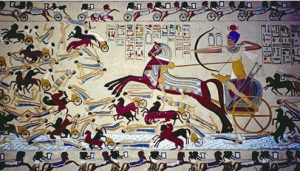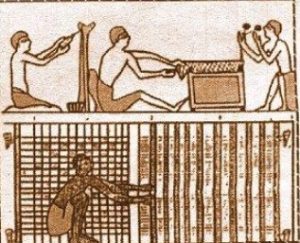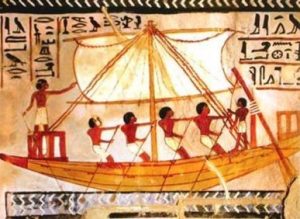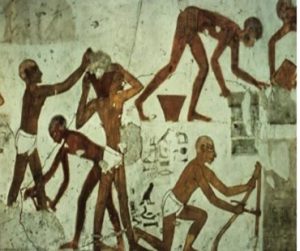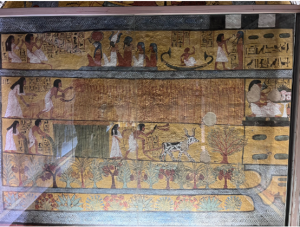Ancient Egyptian Society
Ancient Egyptian society was structured into a hierarchical system, often visualized as a pyramid. •The Upper Class: At the apex of this social pyramid was the pharaoh, his family, and his court. •The Middle Class: This class included lower-level officials, artists, and artisans. •The Commoners: This broad category encompassed farmers, herders, laborers, and those engaged in small-scale trades and services.
The Pharaoh
Seen as the son of a god on Earth, the pharaoh combined the divine authority of the gods with the power of a king. He was the supreme commander of the army and the high priest of all Egyptian temples. In some administrative matters, the vizier acted on his behalf. -king Thutmose III
The Vizier
The vizier was essentially the prime minister of the pharaoh’s realm. As the pharaoh’s deputy, he oversaw administration and the treasury. Some viziers were also skilled architects and physicians. A famous example is Imhotep, who designed the Step Pyramid of Djoser and was later deified as a god of healing and medicine. -Minister Mereruka from the old state, sixth dynasty
The Priests
Priests held great reverence and respect in ancient Egyptian society. The high priest of each temple was considered an advisor to the pharaoh. Some pharaohs even made their sons high priests in temples. A notable example is Thutmose III, who became a priest at the Karnak Temple, heir to the throne, and eventually pharaoh of all Egypt. In the 21st Dynasty, some priests became actual rulers of the land, governing from Thebes. The most famous among them was Pinedjem, whose statue is prominently displayed at the Karnak Temple. Priests played a pivotal role in religious life (Religion deeply influenced the Egyptian psyche). Priests were responsible for propagating and promoting the pharaoh’s divine status. A prime example of this is the invention of the divine birth narrative for Hatshepsut, which was a form of political propaganda. Priests also performed essential religious duties within temples, such as offering sacrifices to the gods. Priests played a significant economic role in ancient Egypt. It was customary for the pharaoh, as the owner of Egypt’s land, to grant portions of it as estates to temples. As a result, priests oversaw large agricultural estates, employing farmers to cultivate the land. Once the harvest was gathered, a portion was given to the farmers, another to feed the temple’s livestock, and the remainder was stored in granaries under the supervision of the priests. Livestock was raised on the temple estates and sacrificed daily to the gods, with some meat distributed to the poor and the remainder consumed by the priests.
Ritual Purity and Daily Duties
Priests were required to maintain a high degree of ritual purity. Before performing their duties, they would purify themselves in a sacred lake, often connected to the Nile River, symbolizing the primordial waters of creation. The high priest had the daily task of purifying and dressing the temple’s main statue, which represented the deity.
Women in Temple Service
Temple service was not exclusively for men. Women could also hold important positions, with some achieving the prestigious title of “God’s Wife.” -Grain silos from the temple of Ramesseum
Statue of Shebnobet Second Divine Wife of Amon Berlin Museum
Provincial Governors
Ancient Egypt was divided into provinces, each governed by a ruler appointed by the pharaoh. These governors acted as the pharaoh’s representatives, overseeing the administration of their respective provinces. They were subject to the authority of the vizier and were required to submit regular reports on the conditions within their territories. Each provincial governor was assisted by a team of officials who were responsible for various administrative tasks. Over time, these governorships became hereditary, and provincial rulers began to view their territories as personal fiefdoms. During periods of political instability, such as the First Intermediate Period, provincial governors became increasingly powerful and independent. In some cases, they even commissioned the creation of religious texts, such as the Pyramid Texts, to be inscribed on their own tombs, a practice that became widespread among provincial rulers during this era. -Wall picture for one of the governors of the regions
Scribes
In ancient Egypt, the scribe was considered the keeper of the pharaoh’s secrets and the guardian of the legacy of the gods Thoth and Seshat, the goddesses of writing. This role gave scribes a prominent position in ancient Egyptian society. Scribes were responsible for recording the words dictated to them by pharaohs, containing royal secrets, or by priests, containing divine secrets. Depictions of scribes often show them seated, facing the person speaking, with a writing table in front of them and a reed pen in hand, either reading what they had written or listening intently to what was being dictated. Numerous statues of scribes have been discovered, one of the most famous being the Egyptian scribe statue housed in the Louvre Museum.
Goddess Seshat
god Thoth
The statue of the Egyptian writer at the Louvre Museum in Paris discovered by Mariette in Saqqara
Soldiers in Ancient Egypt
Soldiers in ancient Egypt were divided into two main categories: 1.Internal Security Forces: These soldiers were akin to modern-day police forces. Their primary duties included protecting property, especially tombs, from thieves, and safeguarding the nation against raids from nomadic tribes. 2.The Military: This was the more prominent force and was responsible for external defense, guarding Egypt’s borders. -Wall photography of King Ahmose against the Hyksos and shows the Egyptian soldiers
Craftsmen in Ancient Egypt
Ancient Egyptian craftsmen employed a wide range of materials and tools in their work: •Leather: Leather was used to create sandals, chair coverings, and even as a writing surface, particularly the white leather used in conjunction with papyrus. •Bronze: Bronze was used in small statues and figurines. •Wood: Cedar wood was imported from Lebanon to construct ships and coffins, while ebony from Nubia was used for royal furniture. •Linen: Linen was a staple material for making clothing. •Papyrus: The Egyptians were pioneers in papermaking, using the papyrus plant to create sheets for writing. The plant’s stalks were also used to make mats and baskets. -Craftsmen make linen fabric
Traders in Ancient Egypt
Trade in ancient Egypt was primarily based on a barter system, which involved exchanging goods for other goods rather than using currency. Ancient Egyptians required various commodities that were not native to their land, such as woods from Lebanon and Syria, and henna and perfumes from the land of Punt. To acquire these goods, Egypt exported its surplus of grain, barley, linen, and most notably, papyrus. To facilitate this trade, Egyptians maintained both a naval fleet for long-distance maritime trade and a river fleet. they also used domesticated animals as pack animals in trade between villages. -Merchant ships in ancient Egypt
The Working Class
The role of the pharaohs in ancient Egypt extended beyond simply ruling the people; they were also deeply concerned with the economic well-being of their subjects. The ancient Egyptian year was divided into three seasons: flooding, planting, and harvest. During the flooding season, when agricultural work ceased, farmers were conscripted to work on royal projects, such as building temples and tombs. Since most tombs were located on the west bank of the Nile, while the populace lived on the east, special settlements were established near these construction sites to house the workers. A famous example is the workers’ town near the Pyramid of Khufu, which has been recently discovered. Another, and perhaps more well-known, is Deir el-Medina, located near the Valley of the Kings. In Deir el-Medina, skilled workers were even permitted to construct their own tombs, one of the most famous being that of Sennedjem. -Drawing of workers making bricks from the cemetery of Rakhmira in Luxor

